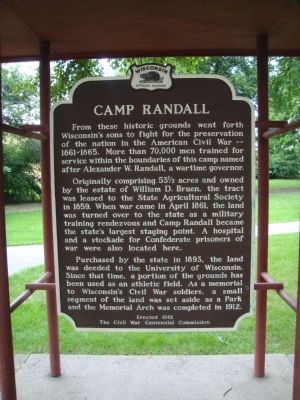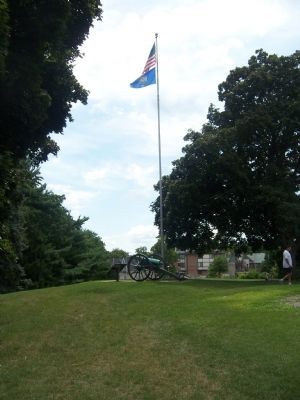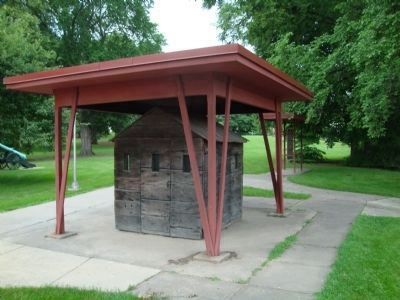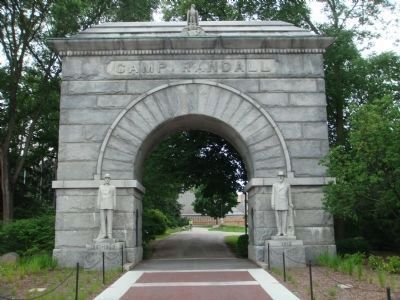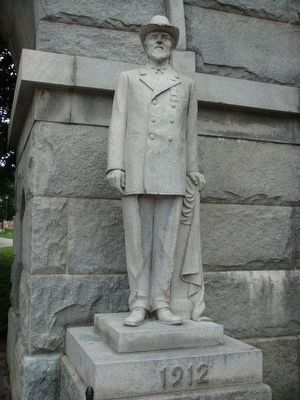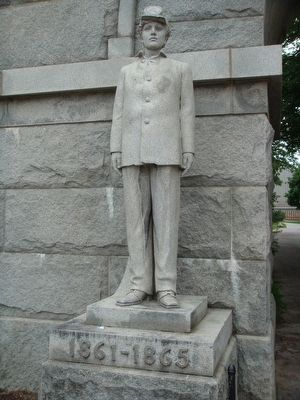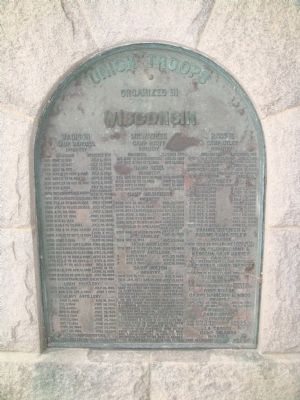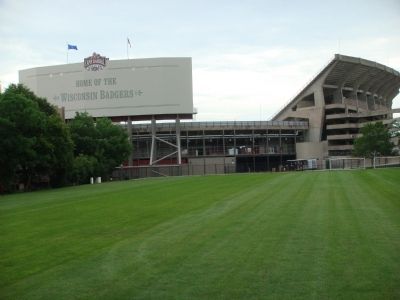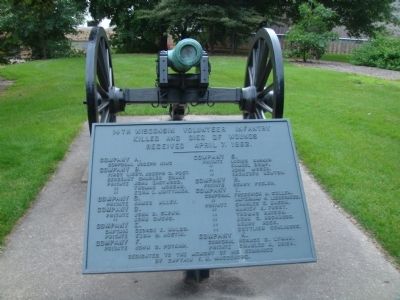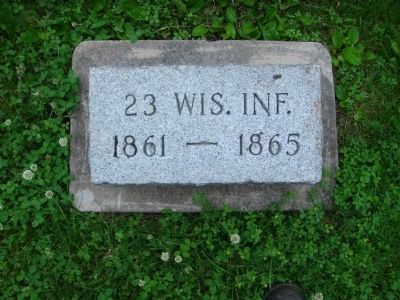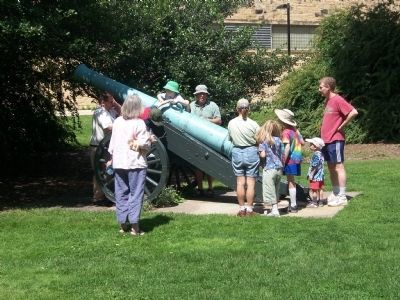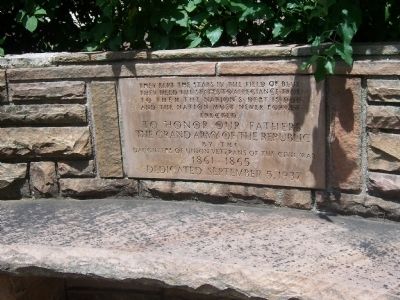Madison in Dane County, Wisconsin — The American Midwest (Great Lakes)
Camp Randall
Originally comprising 53½ acres and owned by the estate of William D. Bruen, the tract was leased to the State Agricultural Society in 1859. When war came in April 1861, the land was turned over to the state as a military training rendezvous and Camp Randall became the state's largest staging point. A hospital and a stockade for Confederate prisoners of war were also located here.
Purchased by the state in 1893, the land was deeded to the University of Wisconsin. Since that time, a portion of the grounds has been used as an athletic field. As a memorial to Wisconsin's Civil War soldiers, a small segment of the land was set aside as a Park and the Memorial Arch was completed in 1912.
Erected 1961 by The Civil War Centennial Commission. (Marker Number 111.)
Topics and series. This historical marker is listed in these topic lists: Military • War, US Civil. In addition, it is included in the Wisconsin Historical Society series list. A significant historical month for this entry is April 1861.
Location. 43° 4.192′ N, 89° 24.599′ W. Marker is in Madison, Wisconsin, in Dane County. Marker is on Monroe Street, 0.1 miles west of North Randall Avenue, on the right when traveling west. Marker is located in the Camp Randall Memorial Park by the side of the University of Wisconsin's Camp Randall Sports Center. Touch for map. Marker is at or near this postal address: 1430 Monroe Street, Madison WI 53711, United States of America. Touch for directions.
Other nearby markers. At least 8 other markers are within walking distance of this marker. Lincoln in Wisconsin (about 500 feet away, measured in a direct line); Fire Station #4 (about 500 feet away); Barry Alvarez (about 600 feet away); Pat Richter (about 600 feet away); University of Wisconsin Field House (approx. 0.2 miles away); Terrace Homes Apartments (approx. 0.2 miles away); The Nurses Dormitory (approx. ¼ mile away); First Chemical Synthesis of a Gene (approx. ¼ mile away). Touch for a list and map of all markers in Madison.
Additional commentary.
1.
Note To Editor only visible by Contributor and editor
— Submitted June 11, 2010, by William J. Toman of Green Lake, Wisconsin.
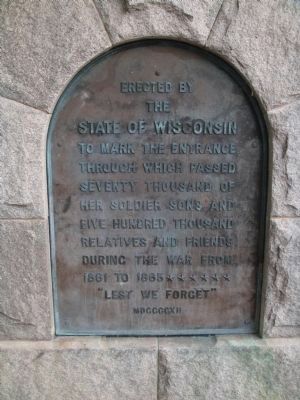
Photographed By William J. Toman, June 10, 2010
7. Camp Randall Memorial Arch
Plaque on Arch:
Erected by the State of Wisconsin to mark the entrance through which passed seventy thousand of her soldier sons and five hundred thousand relatives and friends during the war from 1861 to 1865 ******
"Lest we forget"
MDCCCCXII
Erected by the State of Wisconsin to mark the entrance through which passed seventy thousand of her soldier sons and five hundred thousand relatives and friends during the war from 1861 to 1865 ******
"Lest we forget"
MDCCCCXII
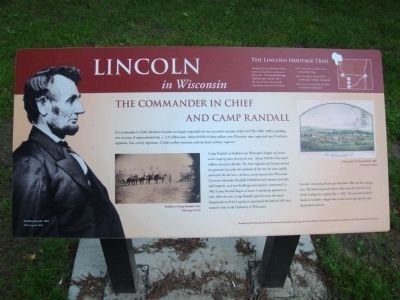
Photographed By William J. Toman, June 10, 2010
10. Related Marker near Camp Randall Marker
"Lincoln in Wisconsin
"The Lincoln Heritage Trail
"Abraham Lincoln had limited but direct and significant contacts in Wisconsin. The Lincoln Heritage Trail identifies and describes the sites of these contacts and encourages citizens to visit them.
"1832: The Black Hawk War, (1) Rock River Valley
"1859: Speaking Tour (1859), (2) Milwaukee, (3) Beloit, (4) Janesville
"1861-65: Commander in Chief (5) Madison-Camp Randall
"The Commander in Chief and Camp Randall
"As Commander in Chief, Abraham Lincoln was largely responsible for the successful outcome of the Civil War (1861-1865), presiding over an army of unprecedented size -- 2.3 million men. About 91,000 of these soldiers were Wisconsin men, organized into 53 infantry regiments, four cavalry regiments, 12 light artillery batteries, and one heavy artillery regiment.
"Camp Randall in Madison was Wisconsin's largest and most active staging point during the war. About 70,000 of the state's soldiers trained at the site. The State Agricultural Society owned the grounds, but with the outbreak of the war the state rapidly converted the site into a military camp named after Wisconsin Governor Alexander Randall. Exhibition halls became barracks and hospitals, and new buildings were quickly constructed. In 1862 Camp Randall began to house Confederate prisoners as well. After the war, Camp Randall again became the state's fairgrounds until the Legislature purchased the land in 1893 and turned it over to the University of Wisconsin.
"Lincoln's domestic policies also had their effect on the campus area. The most important direct effect was the Morrill Land Grant College Act, signed July 2, 1862. This provided federal funds to establish colleges that would teach agricultural and mechanical sciences.
"Produced by the Wisconsin Lincoln Bicentennial Commission and supported by the Madison Community Foundation. Designed by the Wisconsin Historical Society."
Includes 3 photos: "Abraham Lincoln, 1864, WHi Image ID 48683"; "Artillery at Camp Randall, 1861, WHi Image ID 4225"; and "Lithograph of Camp Randall, 1864, WHi Image ID 1838."
"The Lincoln Heritage Trail
"Abraham Lincoln had limited but direct and significant contacts in Wisconsin. The Lincoln Heritage Trail identifies and describes the sites of these contacts and encourages citizens to visit them.
"1832: The Black Hawk War, (1) Rock River Valley
"1859: Speaking Tour (1859), (2) Milwaukee, (3) Beloit, (4) Janesville
"1861-65: Commander in Chief (5) Madison-Camp Randall
"The Commander in Chief and Camp Randall
"As Commander in Chief, Abraham Lincoln was largely responsible for the successful outcome of the Civil War (1861-1865), presiding over an army of unprecedented size -- 2.3 million men. About 91,000 of these soldiers were Wisconsin men, organized into 53 infantry regiments, four cavalry regiments, 12 light artillery batteries, and one heavy artillery regiment.
"Camp Randall in Madison was Wisconsin's largest and most active staging point during the war. About 70,000 of the state's soldiers trained at the site. The State Agricultural Society owned the grounds, but with the outbreak of the war the state rapidly converted the site into a military camp named after Wisconsin Governor Alexander Randall. Exhibition halls became barracks and hospitals, and new buildings were quickly constructed. In 1862 Camp Randall began to house Confederate prisoners as well. After the war, Camp Randall again became the state's fairgrounds until the Legislature purchased the land in 1893 and turned it over to the University of Wisconsin.
"Lincoln's domestic policies also had their effect on the campus area. The most important direct effect was the Morrill Land Grant College Act, signed July 2, 1862. This provided federal funds to establish colleges that would teach agricultural and mechanical sciences.
"Produced by the Wisconsin Lincoln Bicentennial Commission and supported by the Madison Community Foundation. Designed by the Wisconsin Historical Society."
Includes 3 photos: "Abraham Lincoln, 1864, WHi Image ID 48683"; "Artillery at Camp Randall, 1861, WHi Image ID 4225"; and "Lithograph of Camp Randall, 1864, WHi Image ID 1838."
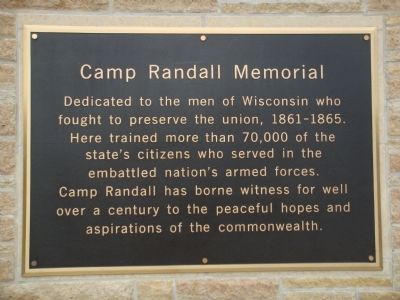
Photographed By William J. Toman, June 10, 2010
13. Related Marker on Camp Randall Sports Facility
"Camp Randall Memorial: Dedicated to the men of Wisconsin who fought to preserve the union, 1861-1865. Here trained more than 70.000 of the state's citizens who served in the embattled nation's armed forces. Camp Randall has borne witness for well over a century to the peaceful hopes and aspirations of the commonwealth."
Credits. This page was last revised on June 16, 2016. It was originally submitted on June 10, 2010, by William J. Toman of Green Lake, Wisconsin. This page has been viewed 4,350 times since then and 72 times this year. Photos: 1. submitted on June 11, 2010, by William J. Toman of Green Lake, Wisconsin. 2. submitted on June 10, 2010, by Gordon Govier of Fitchburg, Wisconsin. 3, 4, 5, 6, 7, 8, 9, 10, 11, 12, 13. submitted on June 11, 2010, by William J. Toman of Green Lake, Wisconsin. 14, 15. submitted on June 10, 2010, by Gordon Govier of Fitchburg, Wisconsin. • Craig Swain was the editor who published this page.
